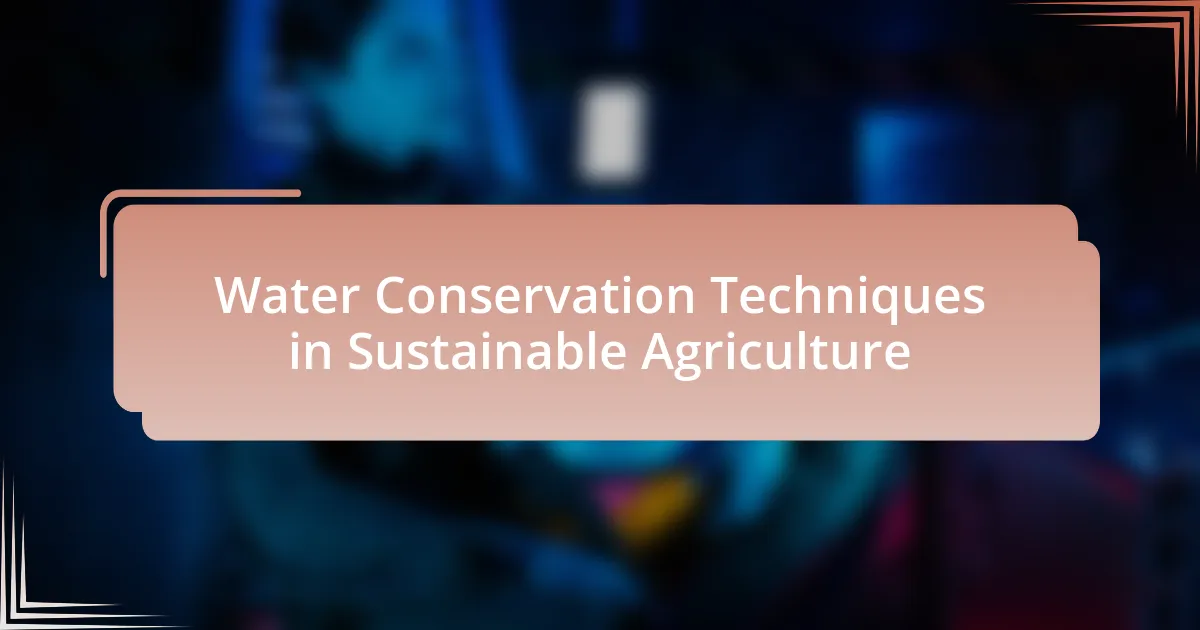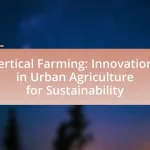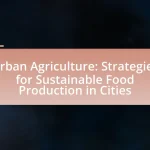Water conservation techniques in sustainable agriculture are essential practices aimed at optimizing water use and enhancing sustainability in farming. Key methods include drip irrigation, which delivers water directly to plant roots, rainwater harvesting for alternative water sources, and soil moisture management techniques like mulching and cover cropping. These practices not only reduce water consumption significantly but also improve soil health and crop yields. The article explores the principles behind these techniques, their economic benefits, challenges faced by farmers regarding water scarcity, and the impact of climate change on water availability, providing a comprehensive overview of effective strategies for sustainable agricultural practices.

What are Water Conservation Techniques in Sustainable Agriculture?
Water conservation techniques in sustainable agriculture include practices such as drip irrigation, rainwater harvesting, soil moisture management, and crop selection. Drip irrigation delivers water directly to the plant roots, minimizing evaporation and runoff, which can reduce water usage by up to 60% compared to traditional irrigation methods. Rainwater harvesting captures and stores rainwater for agricultural use, providing an alternative water source and reducing dependency on groundwater. Soil moisture management involves techniques like mulching and cover cropping to retain soil moisture and improve water infiltration. Additionally, selecting drought-resistant crop varieties can enhance resilience to water scarcity, ensuring sustainable yields even in arid conditions. These techniques collectively contribute to efficient water use and promote sustainable agricultural practices.
How do these techniques contribute to sustainable farming practices?
Water conservation techniques significantly enhance sustainable farming practices by optimizing water use and reducing waste. These techniques, such as drip irrigation and rainwater harvesting, ensure that crops receive adequate moisture while minimizing evaporation and runoff. For instance, drip irrigation can reduce water usage by up to 60% compared to traditional methods, leading to lower water consumption and improved crop yields. Additionally, rainwater harvesting allows farmers to collect and store rainwater, providing a supplementary water source during dry periods, which further supports crop resilience and reduces dependency on groundwater. These practices not only conserve water but also promote soil health and biodiversity, contributing to the overall sustainability of agricultural systems.
What are the key principles behind water conservation in agriculture?
The key principles behind water conservation in agriculture include efficient irrigation practices, soil moisture management, and crop selection. Efficient irrigation practices, such as drip irrigation and sprinkler systems, minimize water loss and ensure that crops receive the necessary moisture directly at the root zone. Soil moisture management involves techniques like mulching and cover cropping, which enhance soil structure and reduce evaporation. Additionally, selecting drought-resistant crop varieties can significantly lower water usage while maintaining yield. These principles are supported by studies indicating that implementing efficient irrigation can reduce water use by up to 50%, while proper soil management can increase water retention by 20-30%.
How do these techniques impact soil health and crop yield?
Water conservation techniques significantly enhance soil health and crop yield by improving moisture retention and reducing erosion. These practices, such as mulching, cover cropping, and drip irrigation, help maintain soil structure and fertility. For instance, studies show that mulching can increase soil organic matter by up to 30%, which in turn boosts nutrient availability for crops. Additionally, implementing drip irrigation can lead to yield increases of 20-50% in various crops due to more efficient water use. These techniques not only promote healthier soils but also contribute to higher agricultural productivity, demonstrating their critical role in sustainable farming practices.
Why is water conservation critical in agriculture?
Water conservation is critical in agriculture because it ensures sustainable crop production while minimizing water scarcity. Agriculture accounts for approximately 70% of global freshwater use, making efficient water management essential to meet the growing food demand without depleting water resources. Effective water conservation practices, such as drip irrigation and rainwater harvesting, can reduce water usage by up to 50% compared to traditional methods, thereby enhancing crop yields and preserving vital water supplies for future generations.
What challenges do farmers face regarding water scarcity?
Farmers face significant challenges regarding water scarcity, primarily including reduced crop yields, increased production costs, and competition for water resources. Water scarcity directly impacts crop growth, leading to lower yields; for instance, studies show that a 10% reduction in water availability can decrease yields by up to 50% for certain crops. Additionally, farmers often incur higher costs for irrigation technologies and water sourcing, which can strain their financial resources. Furthermore, competition for limited water supplies from urban areas and industrial users exacerbates the situation, making it difficult for farmers to secure the necessary water for their agricultural practices.
How does climate change affect water availability for agriculture?
Climate change significantly reduces water availability for agriculture by altering precipitation patterns and increasing evaporation rates. As global temperatures rise, regions experience more intense droughts and irregular rainfall, leading to water scarcity. For instance, the Intergovernmental Panel on Climate Change (IPCC) reports that many agricultural areas are projected to face decreased water supply due to changing climate conditions, which can lead to reduced crop yields and increased competition for water resources. This evidence underscores the critical impact of climate change on agricultural water availability.
What are the different types of water conservation techniques used in agriculture?
Different types of water conservation techniques used in agriculture include drip irrigation, rainwater harvesting, mulching, and crop rotation. Drip irrigation delivers water directly to the plant roots, minimizing evaporation and runoff, which can increase water efficiency by up to 90% compared to traditional methods. Rainwater harvesting involves collecting and storing rainwater for agricultural use, which can significantly reduce dependence on groundwater and surface water sources. Mulching, the practice of covering the soil with organic or inorganic materials, helps retain soil moisture and reduce evaporation. Crop rotation enhances soil health and can improve water retention, as different crops have varying water needs and root structures. These techniques collectively contribute to sustainable agricultural practices by optimizing water use and enhancing crop yields.
What is rainwater harvesting and how is it implemented?
Rainwater harvesting is the process of collecting and storing rainwater for reuse, primarily for irrigation and other agricultural purposes. It is implemented through various methods, including rooftop collection systems, where rainwater is directed from roofs into storage tanks, and surface runoff collection, where water is gathered from land surfaces into ponds or reservoirs. According to the Food and Agriculture Organization, rainwater harvesting can significantly enhance water availability in arid and semi-arid regions, improving crop yields and promoting sustainable agricultural practices.
How does drip irrigation work and what are its benefits?
Drip irrigation works by delivering water directly to the root zone of plants through a network of tubing and emitters, minimizing evaporation and runoff. This method involves a system of pipes, valves, and emitters that release water slowly and precisely, ensuring that plants receive the necessary moisture without excess. The benefits of drip irrigation include increased water efficiency, as it can reduce water usage by up to 50% compared to traditional irrigation methods, and improved crop yields due to consistent moisture levels. Additionally, it helps in reducing weed growth and soil erosion, contributing to sustainable agricultural practices.
What role does mulching play in water conservation?
Mulching plays a crucial role in water conservation by reducing evaporation from the soil surface. This practice involves covering the soil with organic or inorganic materials, which helps maintain soil moisture levels by acting as a barrier against direct sunlight and wind. Research indicates that mulched areas can retain up to 50% more moisture compared to bare soil, significantly decreasing the need for irrigation. Additionally, mulching improves soil structure and promotes water infiltration, further enhancing water conservation efforts in sustainable agriculture.
How can farmers effectively implement water conservation techniques?
Farmers can effectively implement water conservation techniques by adopting practices such as drip irrigation, rainwater harvesting, and soil moisture management. Drip irrigation delivers water directly to the plant roots, reducing evaporation and runoff, which can save up to 60% more water compared to traditional irrigation methods. Rainwater harvesting allows farmers to collect and store rainwater for irrigation, providing a sustainable water source during dry periods. Additionally, soil moisture management techniques, such as mulching and cover cropping, enhance soil structure and retention, further minimizing water loss. These methods collectively contribute to more efficient water use in agriculture, supporting sustainable farming practices.
What are the best practices for integrating these techniques into existing systems?
The best practices for integrating water conservation techniques into existing agricultural systems include conducting a thorough assessment of current water usage, selecting appropriate conservation methods, and ensuring stakeholder engagement. Assessing current water usage allows farmers to identify inefficiencies and prioritize areas for improvement. Techniques such as drip irrigation, rainwater harvesting, and soil moisture management can be selected based on specific crop needs and local climate conditions. Engaging stakeholders, including farmers, agricultural advisors, and local communities, fosters collaboration and ensures that the implemented techniques are practical and widely accepted. Research indicates that farms adopting these practices can reduce water usage by up to 50%, demonstrating their effectiveness in enhancing sustainability in agriculture.
How can technology enhance water conservation efforts in agriculture?
Technology can enhance water conservation efforts in agriculture through precision irrigation systems, which optimize water usage by delivering the exact amount of water needed to crops. These systems utilize sensors and data analytics to monitor soil moisture levels and weather conditions, allowing farmers to make informed decisions about irrigation schedules. For instance, a study by the University of California found that implementing drip irrigation can reduce water usage by up to 60% compared to traditional methods, demonstrating the effectiveness of technology in conserving water resources in agricultural practices.
What are the economic benefits of adopting water conservation techniques?
Adopting water conservation techniques yields significant economic benefits, including reduced water costs and increased agricultural productivity. By implementing methods such as drip irrigation and rainwater harvesting, farmers can lower their water usage, leading to decreased utility bills and operational expenses. For instance, a study by the International Water Management Institute found that drip irrigation can increase crop yields by 20-90% while reducing water use by 30-50%. Additionally, water conservation practices can enhance soil health and resilience, resulting in long-term savings and improved crop quality, which can further boost market prices. These economic advantages underscore the importance of water conservation in sustainable agriculture.
How do these techniques reduce operational costs for farmers?
Water conservation techniques in sustainable agriculture reduce operational costs for farmers by optimizing water usage and enhancing crop yields. These techniques, such as drip irrigation and rainwater harvesting, minimize water waste and lower the expenses associated with water sourcing and distribution. For instance, drip irrigation can reduce water usage by up to 60% compared to traditional methods, leading to significant savings on water bills. Additionally, improved soil moisture retention through practices like mulching can decrease the need for frequent irrigation, further cutting costs. Studies have shown that implementing these techniques can lead to a 20-30% increase in crop productivity, allowing farmers to maximize their returns on investment while minimizing resource expenditure.
What financial incentives are available for farmers who practice water conservation?
Farmers who practice water conservation can access various financial incentives, including grants, tax credits, and cost-share programs. For instance, the Environmental Quality Incentives Program (EQIP) offers financial assistance to implement water-saving practices, while the Conservation Stewardship Program (CSP) rewards farmers for maintaining and improving their conservation efforts. Additionally, state and federal tax credits may be available for investments in water-efficient technologies. These incentives are designed to encourage sustainable agricultural practices that enhance water efficiency and promote environmental stewardship.
What common mistakes should farmers avoid when implementing water conservation techniques?
Farmers should avoid the mistake of underestimating the importance of soil health when implementing water conservation techniques. Healthy soil enhances water retention and reduces the need for irrigation, as evidenced by studies showing that well-structured soil can hold up to 50% more water than compacted soil. Additionally, farmers often neglect to tailor their water conservation strategies to specific crop needs, leading to inefficient water use. Research indicates that applying the right amount of water at the right time can increase crop yields by up to 30%. Another common error is failing to monitor and adjust irrigation systems, which can result in overwatering or underwatering. Regular maintenance and monitoring can improve water efficiency by 20-30%, according to agricultural extension services. Lastly, farmers sometimes overlook the benefits of integrating rainwater harvesting systems, which can provide a sustainable water source and reduce dependency on groundwater. Implementing these strategies effectively can significantly enhance water conservation efforts in sustainable agriculture.
How can improper techniques lead to water wastage?
Improper techniques can lead to water wastage by causing inefficient irrigation practices that do not match the crop’s water needs. For instance, over-irrigation can saturate the soil, leading to runoff and evaporation losses, while under-irrigation can stress plants, prompting them to use more water to recover. According to the Food and Agriculture Organization, inefficient irrigation can waste up to 50% of water used in agriculture, highlighting the critical need for proper techniques to optimize water use and minimize wastage.
What are the signs of ineffective water conservation practices?
Signs of ineffective water conservation practices include excessive water runoff, high water bills, and visibly dry or overwatered plants. Excessive runoff indicates that water is not being absorbed efficiently, suggesting poor soil management or inappropriate irrigation methods. High water bills can signal that water is being wasted, often due to leaks or inefficient systems. Additionally, plants that are either wilting from lack of water or showing signs of root rot from overwatering demonstrate that the conservation practices in place are not effectively balancing water needs. These indicators highlight the need for improved strategies in water management within sustainable agriculture.
What practical tips can farmers follow to enhance water conservation in their operations?
Farmers can enhance water conservation in their operations by implementing techniques such as drip irrigation, rainwater harvesting, and soil moisture management. Drip irrigation delivers water directly to the plant roots, reducing evaporation and runoff, which can save up to 60% more water compared to traditional irrigation methods. Rainwater harvesting allows farmers to collect and store rainwater for irrigation, providing a sustainable water source and reducing dependency on groundwater. Additionally, soil moisture management practices, such as mulching and cover cropping, improve soil structure and retention, leading to better water absorption and reduced irrigation needs. These methods collectively contribute to more efficient water use in agricultural practices.


